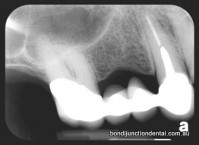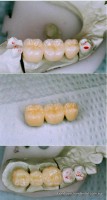Cemented Bridges
PERMANENTLY CEMENTED FIXED BRIDGES
Permanently cemented fixed bridges are used to replace one or more missing teeth by crowning the teeth on either order cheap accutane side of a gap (called abutment teeth). Artificial teeth, called pontics, are attached to the abutment crowns as part of the bridge framework to replace the missing teeth.
The bridge is permanently cemented onto the prepared abutment teeth and can not be removed by the patient.
Bridges are usually made of either porcelain fused to gold or all porcelain.
Occasionally a bridge may be made in two sections joined together with a slot and key way. The key is used when a stress breaker for a long span bridge is required or when abutment teeth are too divergent.
A bridge or crown can be made with a precision attachment containing a clip or stud to better hold a partial denture.
Advantages:
Bridges are permanently cemented and can not be removed.
A patient will have a stronger bite with a bridge than when wearing dentures.
It is common to find very heavily filled teeth adjacent to a space.
Heavily filled weak teeth are prone to fracture and are stronger when crowned. If teeth on either side of a space need to be crowned, the additional costs involved in restoring the missing space with a bridge is much reduced. A bridge will also stop adjacent teeth drifting and tilting.
Disadvantages:
At least two teeth on either side of the gap need to be re-shaped.
Any future problems, such as secondary decay or fractures involving one of the supporting abutment teeth may affect the entire bridge.
Complications:
Cleaning under and around a bridge is different from normal teeth and patients need to be more conscientious in their home care.
As with any teeth and fillings, decay and gum disease can still occur in or around the teeth supporting the bridge if cleaning under the bridge is inadequate.
Rarely the nerve may die after placing a crown or bridge due to the cumulative damage suffered by the tooth over a lifetime and will require a nerve treatment.

X-ray of bridge: Two abutment teeth supporting two missing teeth. One abutment tooth has nerve treatment, post and core

Laboratory photo: three unit porelain bridge